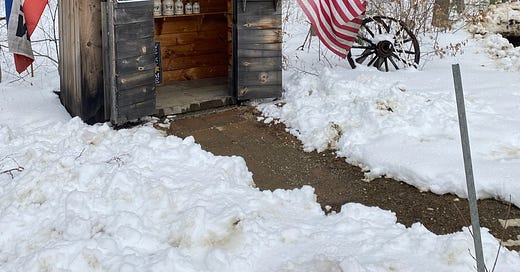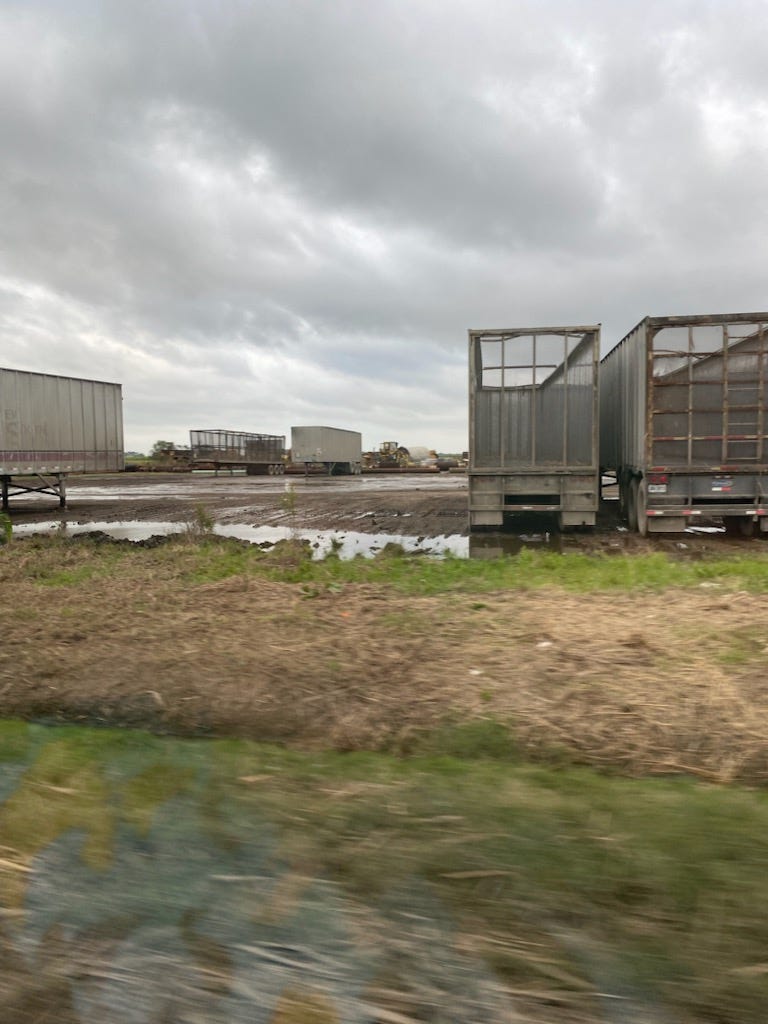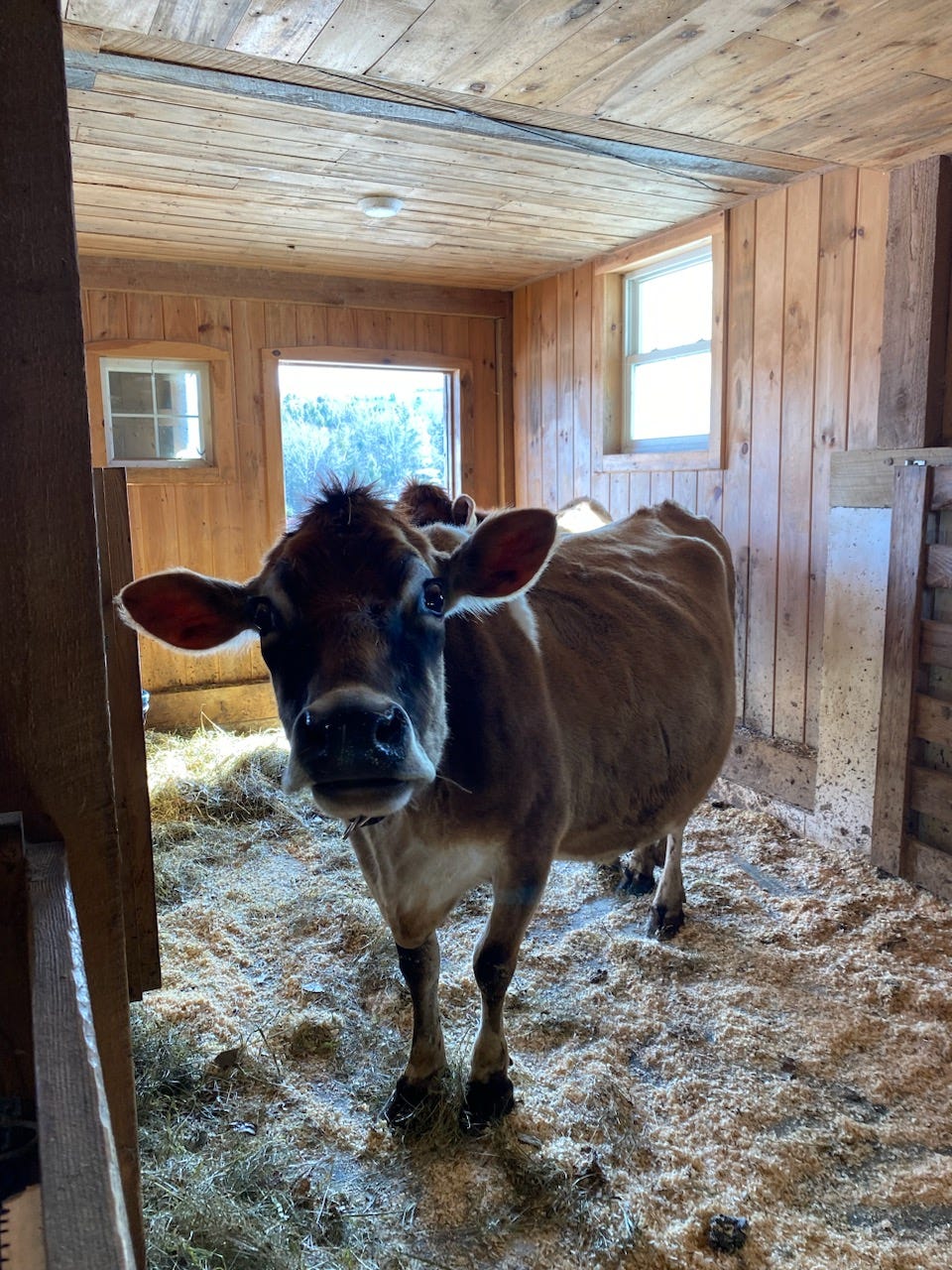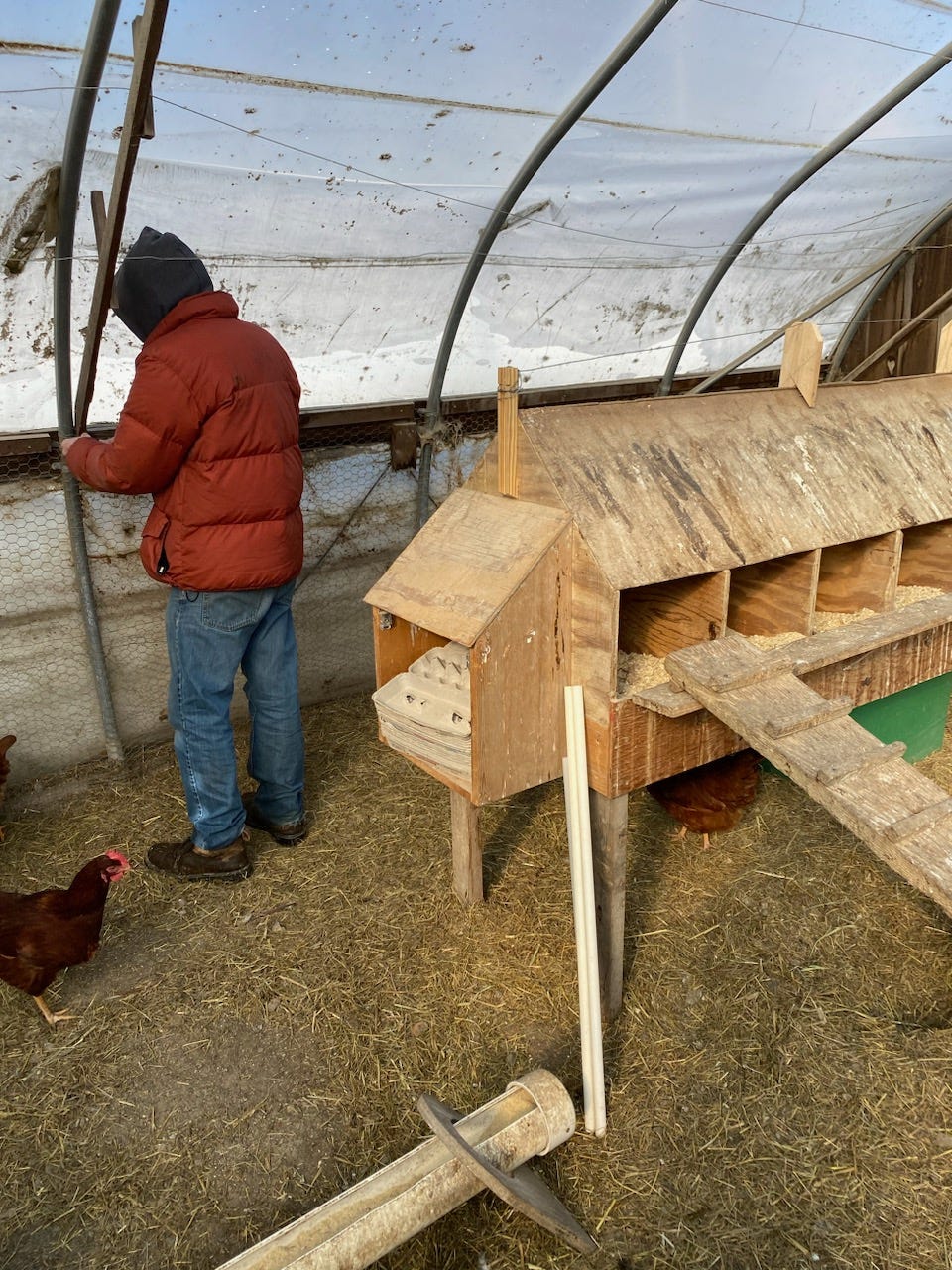I suppose living in an RV bus for two years straight, and living and farming mostly in the desert for the past two winters, has really made me love the snow this year—maybe because we are in the Driftless area of Wisconsin, but I don’t remember the snow ever being so lovely. Clean and icy white, snow banks hugging creeks and topping hills and trees, pillowy mounds capping fence posts or, in sunlight, sparkly dust dripping from pine needles, snow everywhere here looks like a postcard scene. Living in the Chicago suburbs for so long, snow felt fleeting, and sometimes dirty and slushy—living in the woods, it just feels different, more extreme, and also cozier and more magical.
Or, possibly, I just appreciate it more now. I take the boys out every day for a walk, and I just love the walking in snow, even in the sinking in of snow. In Little House in the Big Woods, Laura Ingalls Wilder writes in the chapter “The Sugar Snow”:
Pa came in, shaking the soft snow from his shoulders and stamping it from his boots. “It’s a sugar snow,” he said. Laura put her tongue quickly to a little bit of the white snow that lay in a fold of his sleeve. It was nothing but wet on her tongue, like any snow. She was glad that nobody had seen her taste it.
Sugar snow, of course, actually refers to maple syrup-making snow, an early spring snow that insulates the tree, delaying the leafing of the tree and also keeping the ground from deep freezing. We spent a week in upstate New York and New Hampshire on, yes, farms, where we did participate in maple syrup making, along with other farm chores. It always reminds me what a gift maple syrup is, how capricious its production may become because of climate change, and how much work it truly is to make one little glossy bottle of this amber-hued gold.
In order to make maple syrup, you must drill a small hole, where you are then able to get the sap to drip into a strapped-on bucket. The sap flows in the vascular tissue of the tree, called the xylem, which flow up the tree in thick tube inside the tree. We tap the pressurized sugary water within the xylem that begins to rise as soon as the weather begins to warm just slightly after a long, snowy winter; the cycle of the low-freezing nights followed by above-freezing days makes it so the tiny bubbles in this pressurized liquid expands, forcing it to go up and down the tree, becoming accessible for our tapping into buckets.
In our house, local, Wisconsin-grown organic maple syrup is our main sweetener. We do not use white sugar—barely ever. (We actually do have one jar of it that I use to make kombucha, but I am even phasing that out, since I am trying to make more of kombucha’s cousin, Jun, which uses honey instead of sugar.) There is enough mainstream health news to tell you the depths of the evils of white sugar: studies show that refined sugar can feed cancer cells,1 is harmful to your microbiome,2 and depletes your immune system.
Besides the bodily damage it creates, sugar has also become (and been, for quite sometime) a very unsustainable sweetener choice; it is, to put it mildly, a horribly devastating-to-the-earth crop. An extremely water-intensive crop, sugar cane farms have steamrolled huge swaths of land, destroying biodiversity, creating soil erosion, and producing water and air pollution. Sugar mills, often nearby or right next to these behemoth farms, create emissions and massive quantities of sludge that end up flowing into freshwater and nearby oceans. When we were camping in Louisiana, it was like being in Illinois or Indiana with corn fields; the sugar cane farms were everywhere we drove. Sugar mills dotted the corners of these fields like huge industrial giants, spewing plumes of greyish white out metal stacks like enormous dragon mouths. Pools of silty water were everywhere, flowing out into streets off the land and from factories.
Louisiana’s sugar-cane industry is by itself worth $3 billion, with Domino Sugar (with their omnipresent yellow paper bags) being the largest sugar refinery. The United States sugar industry receives as much as four billion dollars in annual subsidies, fueling America’s soda and drugstore candy addictions.
Sugar cane also has a miserably dark history, steeped in slavery and greed and colonialization, which still permeates today’s sugar culture; sugar farms are largely owned by white people, passed on over generations, resulting a firm grasp on its racist roots. Labor abuse abounds on many farms, keeping steady the caste system of Black workers steeped in hardship, and of white-owned farms and mills making profits off of exploited labor. Though much of slavery’s historical records of destruction have been scrubbed and whitewashed in tours you can take on one of Louisiana’s plantations, the Whitney Plantation Museum does an accurate job of showcasing the state’s sugar history and how this racial hierarchy in the sugar industry still infiltrates, crystallizing the cycle of poverty.
The South is a complicated place. I can only speak to where myself and my family are from, and there are obviously many problems with the deep racism that still lays the groundwork in so many areas. The antebellum reign is still romanticized in so many ways—when I lived in Houston as a kid, I remember a Gone with the Wind-themed party at a school in Texas, a thought that horrifies me now. (Not my school, however—I went to a school in Houston for almost all of my elementary school years, where about half of my teachers and fellow students were Black. Our principal was Black, and so were a lot of our neighbors that lived on our street. People can think of all of the South as solely a bunch of racist white people, but I had never seen so much segregation as I saw when I moved up north to Illinois.) The sugar industry should be looked at as a large example of where racial inequality stems from, and how its systemic racism has carried over today. People are well-versed in the dangers of sugar in terms of obesity and diabetes, but I am always surprised that racist labor conditions and environmental destruction barely ever enter the conversation.
People should avoid cane sugar, in my opinion; it is horrible for the body, awful for humanity, and destructive to the planet. Its very roots are those of pain and devastation, and those sweet sips of Pepsi aren’t worth the demise of one’s health. Does that mean we should always reach for the bottle of organic maple syrup or biodynamic honey? Well, I would yes, but still sparingly. Maple syrup (especially organic) is not likely to be destructive to the environment (tapping a tree only gives the tree a tiny wound, which the tree can heal easily from). Keeping bees, if done right, can be an ecological activity. Maple syrup contains vitamins and minerals, while raw honey contains enzymes that help the digestive and immune systems. That said, maple syrup and honey are also still sugar to the body, and should be not abused. (I am guilty of maple syrup in my coffee every morning—I am one of America’s addicts, too!). Climate change will also affect these sweeteners, of course, like it will affect everything else, in a likely negative way, perhaps another reason to cut down on using them too much.
I think about impacts of food with every bite I eat—every glug of maple syrup is no different. When I bake cookies, I use coconut sugar, which, despite its carbon footprint, is more sustainably made and grown, and contains nutrients. I use honey for tea, or the occasional spread. These are better alternatives than cane sugar for sure, but should still be used thoughtfully and appreciatively. We are in no position to do otherwise.
Yes, we are back from our trip, where we got to visit friends and see farms and got to get ideas/helped work/get inspired. Now it is truly decision time! We have both been offered jobs in, now, multiple states, here or there, and it is just a matter of what we decide to do. The other option: work jobs while also starting a (very) small farm. A microfarm, if you will. At this point, it feels like I should not say anything until we just know what we are doing for sure. Obviously we are really thinking about our financials this time around, and what what we can really afford to do. Obviously spring is about here. So obviously we will figure it out soon, so I will update soon!
What I’m Cooking/Reading:
While we visited a farm in New Hampshire, we worked in the barn with the animals (really making my obsession with getting milking animals again stronger), helped with maple syrup, and harvested spinach from their hoophouse. We also had every meal cooked for us, which was fun! We slept in a one-room cabin down the road, which had no running water, though I would have been ok if not that the road was extremely frightening to walk down and I was constantly afraid of one of us being hit by huge trucks with Trump stickers at all times. So, downsides aside, it was a fun farm to visit/work at for a little bit.
Since I majorly got off my cooking game during this trip, we did have a really good meal at a farm-to-table eatery called the Pickled Owl in New York (I had a stew with mashed sunchokes, reminding me that I like sunchokes and need to grow them this year), and I treated myself to a cookbook from a used bookstore. So, not a lot of cooking, and not even a lot of reading, though I did finish both Tim Herd’s book, Maple Sugar, and Elizabeth Abbott’s Sugar: A Bittersweet History in preparation for this newsletter.
Louisiana State University Health Sciences Center. "More information on how cancer and sugar-sweetened beverages are link." ScienceDaily. ScienceDaily, 3 October 2016. <www.sciencedaily.com/releases/2016/10/161003114046.htm>.
Columbia University Irving Medical Center. "Sugar disrupts microbiome, eliminates protection against obesity and diabetes." ScienceDaily. ScienceDaily, 29 August 2022. <www.sciencedaily.com/releases/2022/08/220829194721.htm>










Great overview of the whole subject of seeeteners. I loved the update and pix at the end—especially the cute pic of the milk cow!